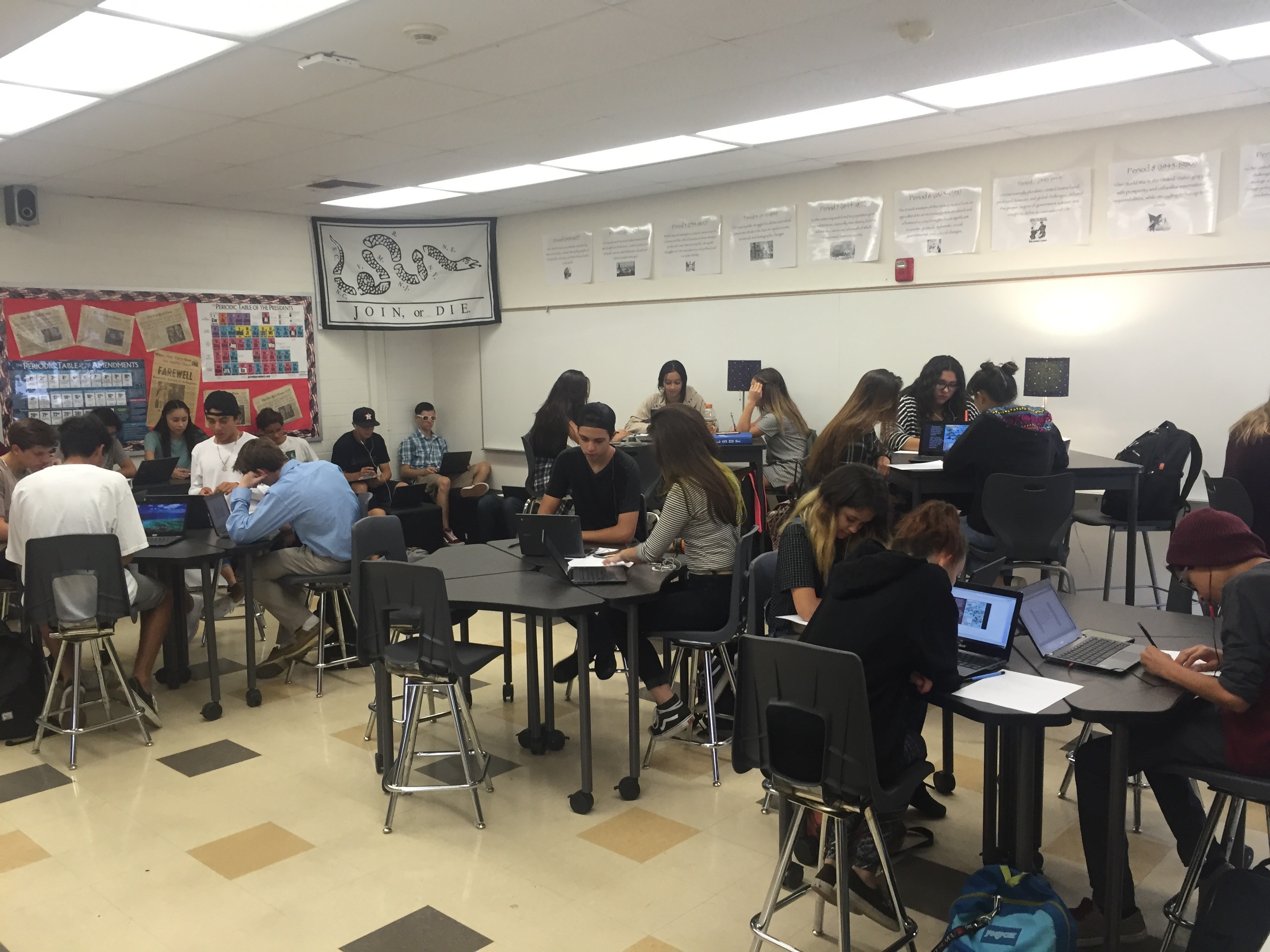PERSONAL: A new program seeks to revolutionize Poly students’ education.
By Brandon Byrne and Jacob Ferrall, Staff Writers
In high schools across the nation, there is a perceived disconnect between students and their education in schools. To address this issue, Poly faculty introduced a new experiment, dubbed “Personalized Learning,” that was launched last April. The program aims to increase student engagement in the classroom by tailoring teaching strategies and class plans to how students learn best. Its essential focuses are in technology, competency based courses, teamwork, creative problem solving and “flexible environments.” There are four classrooms with the “flexible environments,” which involve students sitting in groups without particular seating; through this, the new system encourages teamwork. The new classrooms are designed to transform the classroom into a collaborative community. Both students and teachers will have to adapt to this new educational style. Poly is the first and only school in Riverside Unified School District (RUSD) putting personalized learning into action.
Personalized learning contains many potential advantages. “We are allowing students to have a voice and a choice in their learning,” Mrs. Adrianne Dubuisson, one of the teachers testing the program, said. Students enrolled in a personalized learning class enjoy more liberties than those in normal classes. Mr. Jeffrey Jambretz’s students have the privilege to customize how class is run. “He lets us choose whether we do the ‘traditional’ way with quizzes and tests and a playlists of assignments, or we can do a project,” Noah Ameur (11) said. Personalized learning hands students the freedom to decide their optimal learning path. Teachers seem to be finding that the hands-on activities are the most effective path. Brochton Troutman (12) expresses fondness of this new type of learning in Jambretz’s course. “I am more of a hands on type of learner, and the biggest advantage is the freedom because you also get to choose what kind of assignments you get to do,” Troutman explained.
Teachers are the only group experiencing the drawbacks of personalized learning. “It’s a lot of planning time, and it’s an experiment,” Dubuisson said. They are forced to alter the way they teach a lesson, which can be a challenge.
In a personalized environment, activities and simulations appear more commonly than lectures. “Death by powerpoint, we’re trying to get away from that, and engineer some controversy,” Poly’s Principal Dr. Roe declared. For example, Dubuisson used a Mercantilist simulation to teach her students this economic system. The students were placed in groups to form countries, and their goal was to accumulate wealth through trade under mercantilist policies. “It allowed us to have fun while learning which is more effective, in my opinion, than a lecture,” Christian Martinez (11) said, in favor of the stimulation.
This movement will significantly alter education, because a major objective of personalized learning is to move away from the AP system. This is because, “when Harvard came out here last year, they were telling us this idea that more AP classes equals more rigor is not true,” Roe said. The staff is beginning to discover that the AP needs to be changed because colleges and universities are looking for students with creative problem solving skills and experience working in a team. “AP classes have become nothing more than an exercise of fair disclosure… and by the end of the course, what do you master? You master an exam, not the material,” Roe claimed.
Poly is one of the first involved in a five-year plan of implementing personalized learning, and the goal is to have every teacher participating in personalized learning within those five years. The administration is working to get more teachers on board and increase the number of flexible classrooms. The next step is to finish the library, because Roe plans to make the library like one big coffee shop with lots of space, high ceilings, beautiful wood panels and comfortable seating arrangements. The idea is to make the library student centered and a comfortable environment for students to congregate and work. The library will also be able to hold three classes, so that teachers can teach across content. For example, an English and history teacher could hold their classes simultaneously so that they could tie their lessons together. That is this year’s focus, but the staff will divert their attention to establishing a different element of personalized learning each year. By the last year of implementation, Poly will create learner profiles or records of each student’s learning style, which includes their strengths and weaknesses. That will give teachers an idea of how to design a custom learning plan for each student that conforms to the way they learn best. These changes are only in the preliminary stages, but after a few years, education in Poly will be completely transformed into a new education delivery system that will adapt to every student’s most effective learning style.

